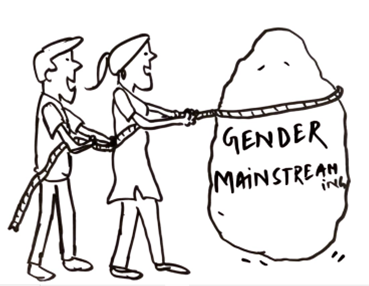
illustration by Author
Rajiv Banerjee (Student of AMPPP Class 2022)
Senior Communication Professional, Mumbai
Across corporates, numerous campaigns run within the organisation on gender sensitisation. These campaigns are often initiated from the top with the leader of the organisation and the senior leadership committing themselves to make the workplace gender sensitive. While these efforts are indeed laudable and are needed, often they fail to percolate down to the last mile. The effort begins with a bang from the corporate office, but often becomes a whimper when it reaches a field office in another state, far away from the headquarters.
This is a conundrum that corporates of all hues are grappling within, in an effort to make the office environment more gender sensitive and achieve gender mainstreaming. At a broader level, gender diversity is becoming important within the Environment Social Governance (ESG) reporting framework. One can opine that it is a good thing, as heightened investor interest is driving the change. Profit motive thus, may help in pushing the gender diversity and mainstreaming narrative inside an organisation. However, trying to bring change with profit or investors’ interest as a cornerstone may push the needle to a certain extent. One is not sure if a holistic transformation can take place keeping only these motives in mind.
So, how can corporates ensure that the message on gender sensitivity filters down across every function inside the organisation? For that, corporates need to work on gender mainstreaming. It is critical that gender mainstreaming is a success, if not in the whole, but at least across a large part of the organisation.
There is no sure-shot silver bullet to achieve this. For corporates, gender sensitivity and mainstreaming is a long journey — one that involves many challenges and milestones. One approach is to not look at the issue top-down, but to have a bottoms-up approach. The idea here is to decentralise and create individual ownership and responsibility across the rank and file.
Breaking the Social Ceiling
Initiatives like ‘career accelerator programmes’ and creating opportunities for women professionals to ‘get back to work’ after a career break are indeed commendable efforts made by organisations. However, the objective of achieving an inclusive workplace has to be seen in the context of the social challenges that women professionals have to face. For example, in the financial services segment, while there are many women hired at entry-level positions in banks, the numbers start to dwindle at the middle management level.
This skew also comes from the socio-economic fabric of the society, due to which, careers of women professionals take a back seat as marriage, family, and societal pressure take precedence. The patriarchal system which feeds the mindset that a career is secondary for daughters is sadly still prevalent in the society. Another scenario that develops post marriage for a woman professional in banks and NBFCs, are location and working hours. Work schedule in a bank branch, for example, also involves late hours for work, particularly during the month-end and financial year-end. Add to that the travel time. These scenarios make it challenging for women professionals to continue with their jobs and at the same time attend to their families.
The good part is that most organisations realise the importance of gender sensitisation. One senior HR professional from a leading private sector bank said, “Manager sensitisation ensures helping managers and leaders understand that being gender diverse makes business sense as diverse customers are represented. Organisations which can reflect the overall diversity in our society tend to be more successful than those which don’t.”
Bottoms-up
Manager sensitisation means encouraging dialogue among employees at a local level. While many organisations have resource groups for women employees to support each other, what is needed is an interaction between both genders in an organisation on this subject. To borrow an advertising catch line from a well-known mobile service provider, ‘barriers break when people talk’ holds true in this scenario. Most of us have our own respective biases and prejudices on gender sensitivity. The top-down approach of adhering to and implementing the initiatives coming from the head office often gets a half-hearted acceptance from employees towards the bottom of the hierarchy. The ‘skin in the game’ happens when an environment is created at the local level for employees to voice their thoughts on gender-specific issues, the challenges, and possible solutions.
Induction programmes for new recruits should be extended to the families of the new joiners. From a gender lens, it emboldens the new recruit and the family if the manager meets the family to welcome him or her into the organisation. In a way, it helps repose confidence in her competency and ability. The objective here is to create an on-ground connect between the line manager and the employee, right from the start.
Just as every employee has key result areas (KRAs) for performance evaluation, organisations can have a Gender Sensitivity Score (GSS) for every employee. The score should be gender agnostic for creating an inclusive workplace and should cut both ends. Scoring should be based on certain achievable parameters like tasks done, for example, surveys and workshops and any noteworthy action undertaken by the line manager or employees which can help propagate gender sensitivity. This can be done every quarter and the top achievers should be acknowledged in the organisation and felicitated by the management.
DISCLAIMER : Any comments, speeches, articles, blogs, podcasts, videos/vlogs, opposite the editorial page/opinions andeditorials page (OP-ED), interview response etc. made by individuals should be accompanied by a clear disclaimer from the ones given below.
“The views expressed in this article are personal. Rajiv Banerjee is a student of the Advanced Management Programme in Public Policy at the Indian School of Business.”

